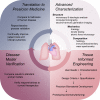Tissue-informed engineering strategies for modeling human pulmonary diseases
- PMID: 30461289
- PMCID: PMC6397349
- DOI: 10.1152/ajplung.00353.2018
Tissue-informed engineering strategies for modeling human pulmonary diseases
Abstract
Chronic pulmonary diseases, including idiopathic pulmonary fibrosis (IPF), pulmonary hypertension (PH), and chronic obstructive pulmonary disease (COPD), account for staggering morbidity and mortality worldwide but have limited clinical management options available. Although great progress has been made to elucidate the cellular and molecular pathways underlying these diseases, there remains a significant disparity between basic research endeavors and clinical outcomes. This discrepancy is due in part to the failure of many current disease models to recapitulate the dynamic changes that occur during pathogenesis in vivo. As a result, pulmonary medicine has recently experienced a rapid expansion in the application of engineering principles to characterize changes in human tissues in vivo and model the resulting pathogenic alterations in vitro. We envision that engineering strategies using precision biomaterials and advanced biomanufacturing will revolutionize current approaches to disease modeling and accelerate the development and validation of personalized therapies. This review highlights how advances in lung tissue characterization reveal dynamic changes in the structure, mechanics, and composition of the extracellular matrix in chronic pulmonary diseases and how this information paves the way for tissue-informed engineering of more organotypic models of human pathology. Current translational challenges are discussed as well as opportunities to overcome these barriers with precision biomaterial design and advanced biomanufacturing techniques that embody the principles of personalized medicine to facilitate the rapid development of novel therapeutics for this devastating group of chronic diseases.
Keywords: biomanufacturing; biomaterials; chronic obstructive pulmonary disease; in vitro; precision disease modeling; pulmonary engineering; pulmonary fibrosis; pulmonary hypertension; regenerative medicine; tissue-informed engineering.
Conflict of interest statement
C. M. Magin is a consultant for Sharklet Technologies, Inc., although there is no perceived conflict of interest. No conflicts of interest, financial or otherwise, are declared by the other authors.
Figures




References
-
- Åhrman E, Hallgren O, Malmström L, Hedström U, Malmström A, Bjermer L, Zhou XH, Westergren-Thorsson G, Malmström J. Quantitative proteomic characterization of the lung extracellular matrix in chronic obstructive pulmonary disease and idiopathic pulmonary fibrosis. J Proteomics 189: 23–33, 2018. doi:10.1016/j.jprot.2018.02.027. - DOI - PubMed
Publication types
MeSH terms
Grants and funding
LinkOut - more resources
Full Text Sources
Medical
Research Materials

